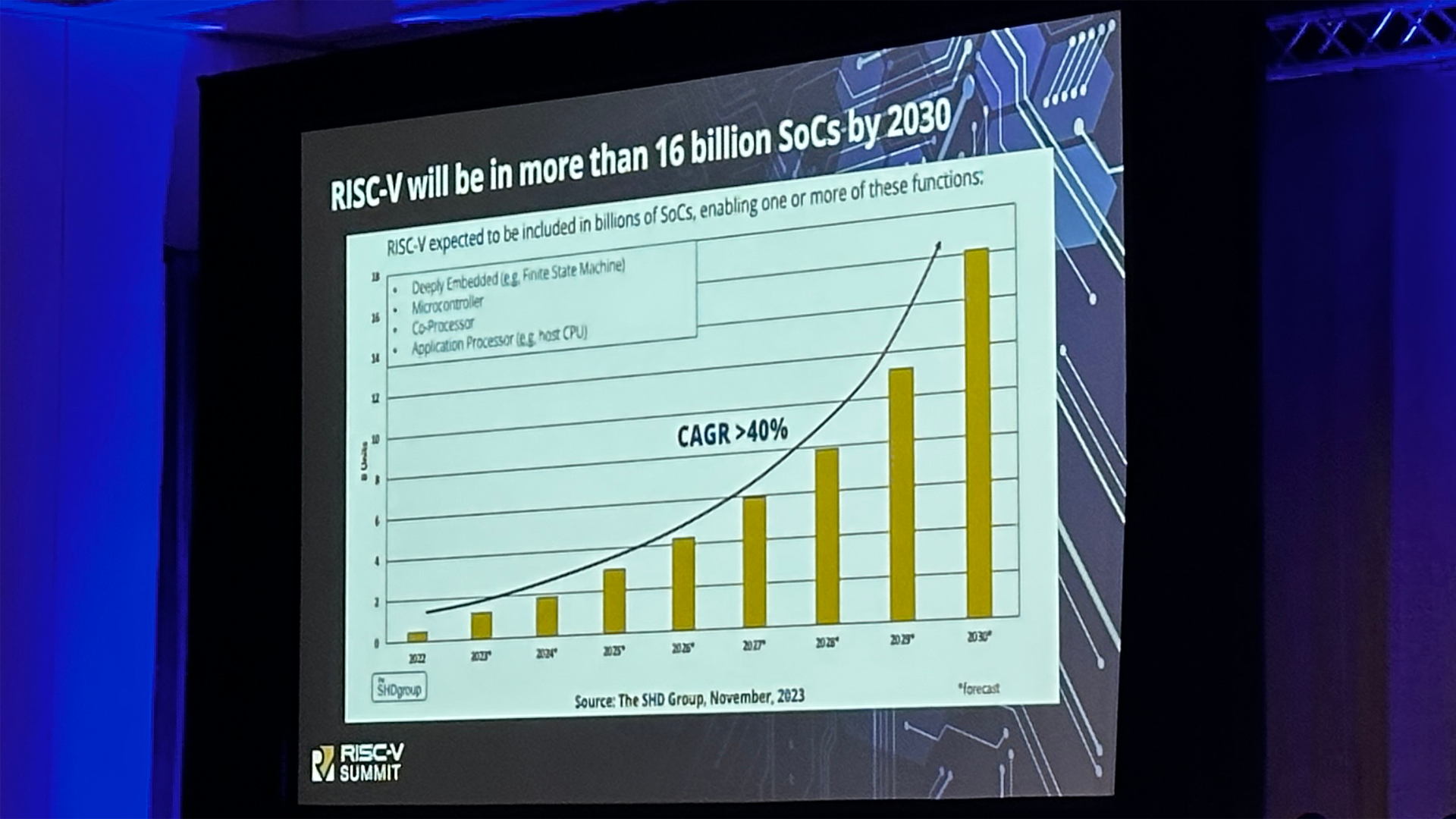More Than 16 Billion RISC-V Chips Forecasted by 2030
The compound annual growth rate of RISC-V is believed to be 40%.

The RISC-V open standard instruction set architecture (ISA) has come a long way since it was introduced in August 2014, and according to RISC-V International, the architecture has already been used inside over a billion chips. But this is only the beginning, as the organization forecasts the technology to land into 16 billion chips by 2030.
At the ongoing RISC-V Summit, Calista Redmond, the chief executive of RISC-V International, demonstrated a slide that forecasts RISC-V adoption to grow at a compound annual growth rate (CAGR) of 40% in the coming years. As a result, by 2030, the instruction set architecture will be used inside 16 billion system-on-chips, which is a massive increase from around 1 billion so far. The actual prediction comes from the SHD Group, which is set to make its RISC-V report available in December.
"We are already in billions of cores around the world, and some analysts have even pointed out that it is getting hard to find any new design starts that do not include RISC-V," said Redmond. "RISC-V is the most profound technical revolution of our time."
RISC-V is widely used for microcontrollers today. For example, Qualcomm uses RISC-V for microcontrollers that accompany its mobile system-on-chips. However, the technology is expanding rapidly, so we are seeing companies like Meta, Intel, Tenstorrent, and Ventana develop RISC-V-based solutions for artificial intelligence and high-performance computing. Over time, the technology will expand even further, for example, to GPUs, like with Imagination and Venata's nascent GPU program.
To make RISC-V-based processors competitive against those powered by Arm and x86 architectures, RISC-V needs a more robust software and hardware ecosystem. Apparently, both are developing at a rapid pace. Currently, RISC-V is supported by over 4,000 software development companies from across the world, and there are plenty of motherboards aimed at software and hardware designers available from the industry.
Get Tom's Hardware's best news and in-depth reviews, straight to your inbox.

Anton Shilov is a contributing writer at Tom’s Hardware. Over the past couple of decades, he has covered everything from CPUs and GPUs to supercomputers and from modern process technologies and latest fab tools to high-tech industry trends.
-
ezst036 A RISC-V future would be more beneficial for us as users and consumers than an ARM future would be. These companies and the things they hide in their proprietary cloaks cannot be trusted.Reply
None of them. -
HaninTH Reply
Unfortunately, there's little we can do to ensure certain govt agencies don't enforce either a watered down security system or backdoors (in some fashion) in these systems as they can not allow us to do anything that doesn't serve them nor have us doing anything they don't know about.ezst036 said:A RISC-V future would be more beneficial for us as users and consumers than an ARM future would be. These companies and the things they hide in their proprietary cloaks cannot be trusted.
None of them.
Alas, I fear paranoia will never elude us, for good reason. -
bit_user Reply"RISC-V is the most profound technical revolution of our time."
It might be an industry revolution, but it's not a technical revolution.
On a technical level, it's all fairly derivative. It pretty much has to be, given that it's royalty-free. There almost can't be any cutting-edge tech in the standard parts of the ISA, by definition. Anything novel, is all covered by patents. -
brucehoult Reply
Sure. So is Arm64. They both stand on the very solid base of things such as MIPS in 1985, or at least 64 bit MIPS III and DEC Alpha in 1991 -1992, with mistakes dropped and just a few innovations.bit_user said:On a technical level, it's all fairly derivative.
Alpha was in fact a very good design which would have been viable today, but it died because of company mismanagement (as did MIPS), not for any technical reasons. Being proprietary, neither can survive their owners -- but MIPS has now switched to the RISC-V ISA and may see a revival.
That is part of the great industry revolution of RISC-V. It doesn't have to be the best, it just has to be Good Enough (and it's better than x86!), and the fact that no one company's misfortune can take it down means that you'll never have to move to yet another new ISA.
RISC as a marketing name has existed in commercial machines for almost 40 years (just over 40 in academia), but the principles are virtually unchanged from the CDC6600 in 1964 and Cray-1 in 1975 (and the new RISC-V Vector extension builds on what Cray did). Sixty years of experience shows that the RISC ideas stand the test of time and are never a bad idea, in any implementation technology. -
bit_user Reply
Jim Keller has said in interviews that he believes Alpha's relaxed memory model (which ARM & others have copied, though I think nobody else has gone quite so far) was partly to blame for its poor adoption. He recounted how they'd often get calls from Windows developers at Microsoft, claiming the CPU was broken. DEC would reply back that they had similar code in their own operating systems they internally developed & sold, and it works just fine. The result was that when Microsoft eventually did get Windows support working, it was probably littered with way more performance-robbing memory barriers than it really needed.brucehoult said:Alpha was in fact a very good design which would have been viable today, but it died because of company mismanagement (as did MIPS), not for any technical reasons.
If Microsoft encountered such difficulties, I'm sure independent software vendors were similarly plagued. That would've hurt 3rd party support for the platform and limited adoption.
Only because it's up against fairly weak competition (x86) and there are geopolitical concerns and economic encumbrances around ARM. If not for those, I'd be less rosy about RISC-V's prospects.brucehoult said:That is part of the great industry revolution of RISC-V. It doesn't have to be the best, it just has to be Good Enough
I hope we'll see some real innovation in the ISA realm, in coming decades. I think current approaches are too inefficient.brucehoult said:you'll never have to move to yet another new ISA.
OpenGL was good enough, until it wasn't. There comes a point where the level of complexity underneath becomes so great that you pay a real penalty for maintaining such a simplistic interface. It forces a lot more work to be done on on each side, to try and recover concurrently that's lost in the translation, and detect invariants which are known on the other side of the ISA boundary.brucehoult said:Sixty years of experience shows that the RISC ideas stand the test of time and are never a bad idea, in any implementation technology.
